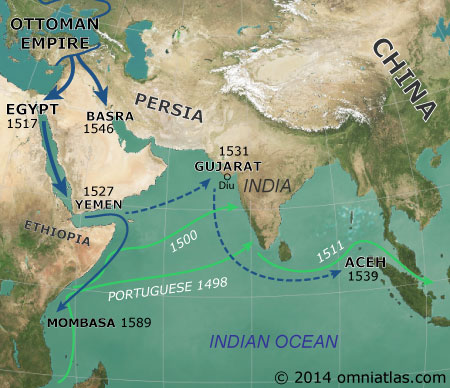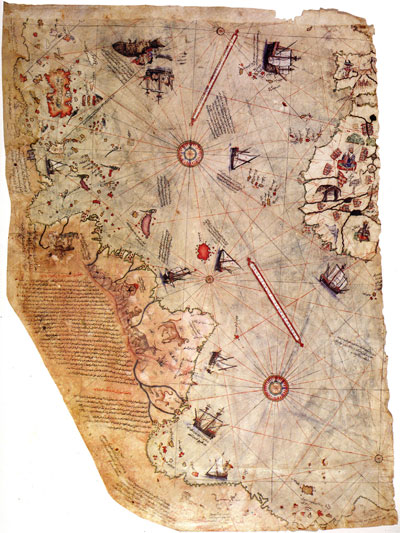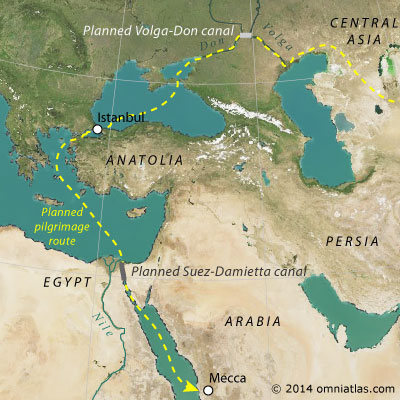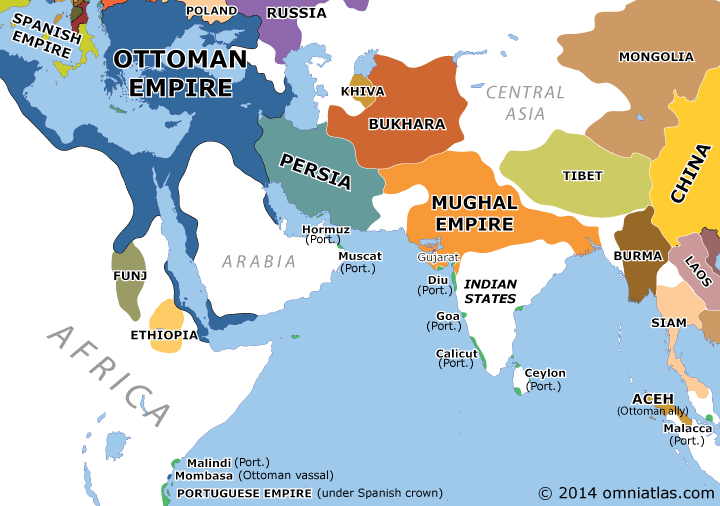The Age of Exploration and the Ottoman Response

Figure 1. Portuguese and Ottoman advances in Indian Ocean
In 1498, after half a century of exploring the African coastline, Portuguese explorers rounded the Cape of Good Hope, burst into the Indian Ocean, and made their way to India. The arrival of the Portuguese, with their well-armed ships and piratical tendencies, seriously disrupted trade in the region, which had hitherto made its way to Europe via Egypt and the Mediterranean.
In 1509, Egypt allied with the Indian sultanate of Gujarat in an attempt to drive out the Portuguese, only to have Portugal's superior navy defeat their combined fleets off the Gujarati coast near the port of Diu. It is possible that the financial strain caused by Portuguese activities fatally weakened the Egyptians, because only eight years later they were conquered by the Ottoman Turks.
Before 1517, the Ottoman Empire had been a strictly Mediterranean power, but its conquest of Egypt in that year gave it control over much of the Red Sea, including the Muslim holy cities of Mecca and Medina, and direct access to the very same wealthy Indian Ocean trade that Portugal had spent so much effort rounding Africa for. Furthermore, the trading states of the Indian Ocean were predominantly Muslim and thus more favorably disposed to the Turks than they were to the Christian Portuguese.
After Egypt, the Ottomans took Yemen, then undercut Portuguese power by sending troops and arms to their new found allies across the Ocean, in particular Gujarat in India and the Sultanate of Aceh in Sumatra. In 1538 and 1546, they launched full scale attacks on Portuguese India itself, only to be thwarted in both cases by Portugal's navy off the coast of Diu.
Why the Ottoman Empire didn't colonize America

Figure 2. Piri Reis map showing Ottoman knowledge of Americas, 1513
By this point, the Ottoman Empire had a fairly sophisticated picture of the world and its oceans. Ottoman spies kept abreast of the latest Spanish and Portuguese cartographic knowledge, to the extent that, by 1513, the Turks were able to produce the Piri Reis map with its detailed depiction of the American coastline.
So why didn't Ottoman conquistadors join their European counterparts in staking a claim in the New World?
The simple answer is that they were much closer to an even greater prize. Until well into the nineteenth century, the Americas were something of a backwater and the main object of international competition was the Indian Ocean and the routes to East Asia. This was a prize on Turkey's doorstep and of much more significance to them than gaining colonies in, say, the Caribbean or Virginia.
Ottoman proximity to the Indian Ocean gave them an economic advantage over the Portuguese, who had to travel the much longer route around Africa to get there. Nonetheless, the Portuguese, as well as the Dutch and English who followed them, considered the trip worthwhile and valued their possessions in that ocean more highly than those in the Americas.
Why the Ottoman Empire didn't build the Suez Canal

Figure 3. Canal routes planned by the Ottoman government
Although the Ottoman Empire was better placed than the European powers to trade with the Indies, it faced a major disadvantage in projecting military power there: for Turkey to build a navy in the Indian Ocean was prohibitively expensive and time-consuming. Timber had to be shipped from Anatolia to Egypt, then moved overland to the Red Sea by pack animals, before it could be constructed into ships in Suez.
The obvious solution to this dilemma would be to build a canal connecting the Mediterranean to the Red Sea - even at the time, it was well known that the ancient Egyptians had done this. However, the task would not be trivial - workers would have to dig through the desert, with its sands and winds. Furthermore, the build up of silt from the Nile over the past few thousand years had probably made the job much more difficult than it was in ancient times.
Nonetheless, in the late 1560s, Grand Vizier Sokullu Mehmed called for a twin canal project. The first would be a Suez-Damietta canal to link the Ottoman Empire to the Red Sea and following roughly the same route as the modern Suez Canal. At the same time, in what is now southern Russia, a Don-Volga canal would be built to secure trading and pilgrimage links with the Muslims of Central Asia, who were feeling increasingly threatened by the expansion of Persia to their south and Russia to their north.
Combined these two canals would have allowed pilgrims to travel almost entirely by water from the Caspian Sea to Mecca, placing the Ottoman Empire firmly in the center of the Muslim world and expanding its influence across much of Asia. But it was not to be, and works on both canals were quickly abandoned as they were judged impractical. Plans for a Suez canal were mooted twice more in the 1580s, but neither came to fruition.
Was building a canal really that daunting? Yes - in the nineteenth century, with the availability of much more modern technology and engineering techniques, it would take the French ten years, involving perhaps 1.5 million employees in all, to construct the modern Suez Canal.
Besides the practical difficulties, canal plans were also held back by religious objections, with clerics disagreeing with the very principle of connecting the Mediterranean with the Red Sea. Although the Ottoman Empire was in many ways more liberal than the Western Europe of the time, such as being more tolerant of religious minorities, in matters of science it could be much more conservative. For instance, it closed observatories because they were believed to be linked to astrology and did not legalize printing until 1727.
There are also geopolitical reasons why the Ottomans didn't build the canal. The political center of the Empire, and the focus of its trade and financial endeavors, was Istanbul and the Sea of Marmara. The attention placed on the Indian Ocean in the 16th Century had already created a powerful rival center in Egypt, with its own faction vying for control in the capital.
If the Ottomans had succeeded in building a canal, they would have made Egypt much more wealthy and powerful, increasing pro-Egyptian power at court and quite possibly destabilizing the Empire or placing Egypt on the road to independence. A thousand years earlier, the Ottomans' Byzantine predecessors had faced similar problems with governing a rich and powerful Egypt.
So from this perspective, the Ottoman choice was between the dangers imposed by the Portuguese presence in the Indian Ocean and the potential dangers of strengthening the power of Egypt. When the Portuguese threat receded after the 1580s, plans for a canal ground to a halt along with Ottoman activity in the Indian Ocean. Eventually the Ottomans would come to rue their neglect of Egypt, but that would be over two hundred years in the future.
The Portuguese and Ottoman declines

Figure 4. Empires in the Indian Ocean, 1589
With the failures at Diu, the Ottoman Empire reverted to a policy of piracy, terrorizing Portuguese shipping across the Indian Ocean. In 1589, they further threatened Portuguese trade routes by setting up fortifications at Mombasa, in what is now Kenya. The Portuguese responded swiftly, besieging and, with substantial African tribal support, capturing the city and its Ottoman admiral.
Mombasa more or less marked the end of the Ottoman-Portuguese struggle. Portugal had already come under the Spanish crown in 1580 and was now an empire in decline. With the end of the Portuguese threat to the Red Sea and Persian Gulf, the interest of the Ottomans in the Indian Ocean dwindled and their focus shifted to Persia, Europe and the Mediterranean.
Other factors also played their part. In India, the Mughals rose to prominence, creating an Islamic empire to rival the Ottomans in size and power. Despite their shared religion, they saw the Turks as a threat and favored the weaker and more manageable Portuguese, contributing significantly to the deterioration of Ottoman influence in the central and eastern Indian Ocean.
Closer to home, a resurgent Persia struck at the Ottoman Empire in 1603. Over the following years, Persian forces pushed the Ottoman frontier back westwards and away from the Persian Gulf, ultimately recapturing Baghdad in 1623. This was a war which threatened the Turkish heartland itself and rightfully demanded more attention and funds than overseas forays.
Persia also struck at Portugal's empire, capturing Bahrain in 1602 and, with English support, Hormuz twenty years later. At the same time, the Persian Shah signed trading agreements with the English and Dutch East India Companies. Although he could not have known it at the time, it would soon be these two companies, rather than any traditional empire, which would rise to dominate the Ocean that the Portuguese and Ottomans had fought so long and hard over.
| [1] | translation from: Casale, Giancarlo. The Ottoman Age of Exploration. Oxford University Press; 2010; p. 150. |